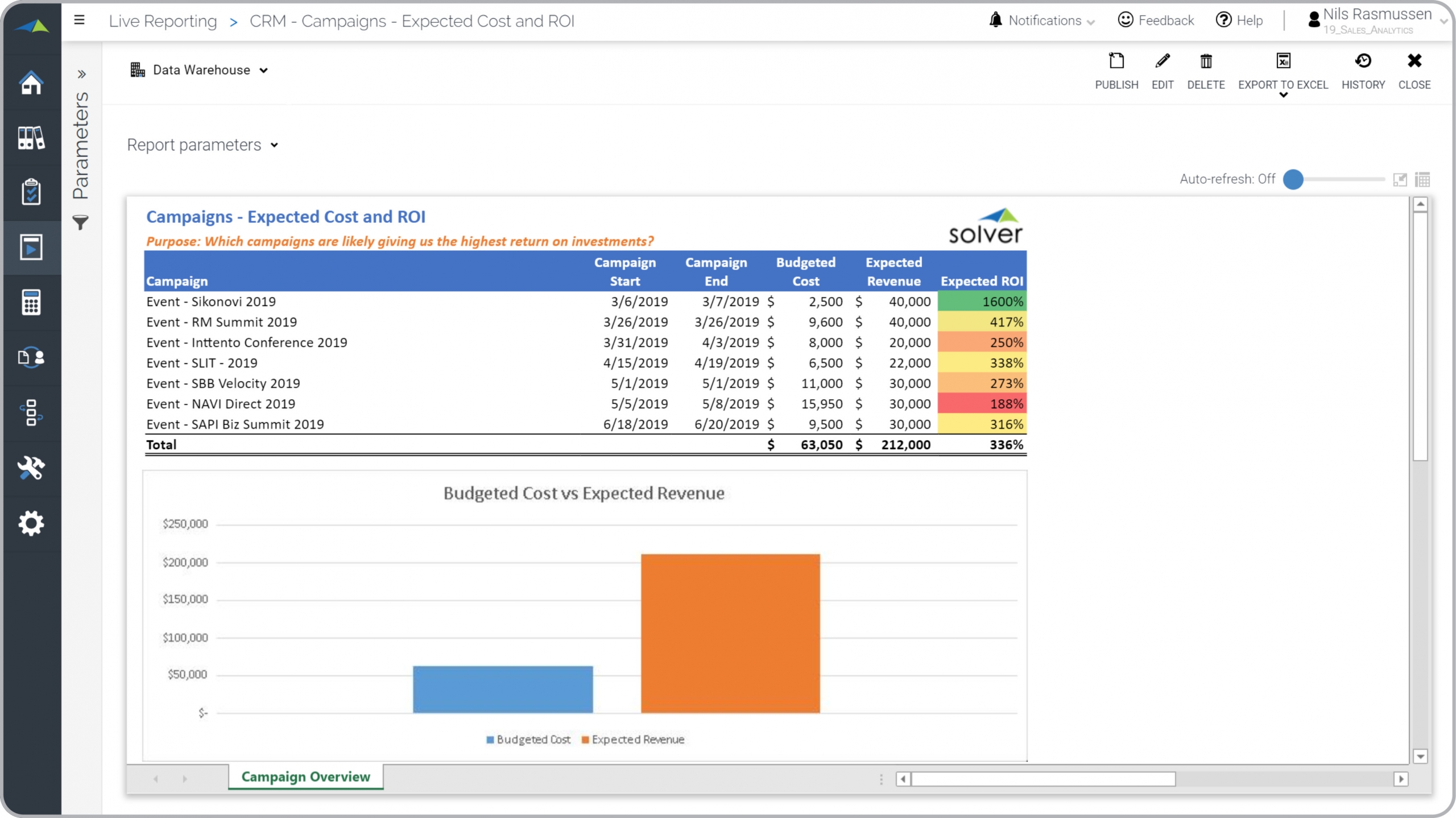Marketing Campaign Report with Cost and ROI Analysis
What is
a
Marketing Campaign Report with Cost and ROI Analysis
? Marketing campaign cost and return on investment (ROI) reports are considered essential marketing analytics tools and are often used by marketing executives and campaign managers to review the cost and performance of campaigns over a selected date range. Some of the key functionality in this type of report is that it provides filters where the user can select all- or specific campaigns for a given time period and see key performance metrics. KPIs include cost, expected revenue and ROI per campaign. Traffic lights and charts makes it easy for the user to see top and bottom performing campaigns. You find an example of this type of report below.
Purpose of
Marketing Campaign ROI Reports Companies and organizations use Marketing Campaign ROI Reports to easily determine which campaigns to keep investing in and which ones to discontinue. When used as part of good business practices in a Marketing department, a company can improve its ability to attract customers and thus help drive sales for the lowest cost per opportunity as well as reduce the chances that money is wasted on money-losing or low ROI marketing campaigns.
Marketing Campaign ROI Report
Example Here is an example of Marketing Campaign ROI Report to analyze cost and estimated return per campaign. [caption id="" align="alignnone" width="2560"]
 Marketing Campaign Report Example with Cost and ROI Analysis[/caption] You can find hundreds of additional examples
here
Who Uses This Type of
Report
? The typical users of this type of report are: Marketing managers, budget managers, sales executives.
Other
Report
s Often Used in Conjunction with
Marketing Campaign ROI Reports Progressive Marketing Departments sometimes use several different Marketing Campaign ROI Reports, along with pipeline reports, campaign dashboards, marketing simulation dashboards, marketing budget models, lead and opportunity reports and other management and control tools.
Where Does the Data for Analysis Originate From? The Actual (historical transactions) data typically comes from enterprise resource planning (ERP) systems like: Microsoft Dynamics 365 (D365) Finance, Microsoft Dynamics 365 Business Central (D365 BC), Microsoft Dynamics AX, Microsoft Dynamics NAV, Microsoft Dynamics GP, Microsoft Dynamics SL, Sage Intacct, Sage 100, Sage 300, Sage 500, Sage X3, SAP Business One, SAP ByDesign, Acumatica, Netsuite and others. In analyses where budgets or forecasts are used, the planning data most often originates from in-house Excel spreadsheet models or from professional corporate performance management (CPM/EPM) solutions.
What Tools are Typically used for Reporting, Planning and Dashboards? Examples of business software used with the data and ERPs mentioned above are:
Marketing Campaign Report Example with Cost and ROI Analysis[/caption] You can find hundreds of additional examples
here
Who Uses This Type of
Report
? The typical users of this type of report are: Marketing managers, budget managers, sales executives.
Other
Report
s Often Used in Conjunction with
Marketing Campaign ROI Reports Progressive Marketing Departments sometimes use several different Marketing Campaign ROI Reports, along with pipeline reports, campaign dashboards, marketing simulation dashboards, marketing budget models, lead and opportunity reports and other management and control tools.
Where Does the Data for Analysis Originate From? The Actual (historical transactions) data typically comes from enterprise resource planning (ERP) systems like: Microsoft Dynamics 365 (D365) Finance, Microsoft Dynamics 365 Business Central (D365 BC), Microsoft Dynamics AX, Microsoft Dynamics NAV, Microsoft Dynamics GP, Microsoft Dynamics SL, Sage Intacct, Sage 100, Sage 300, Sage 500, Sage X3, SAP Business One, SAP ByDesign, Acumatica, Netsuite and others. In analyses where budgets or forecasts are used, the planning data most often originates from in-house Excel spreadsheet models or from professional corporate performance management (CPM/EPM) solutions.
What Tools are Typically used for Reporting, Planning and Dashboards? Examples of business software used with the data and ERPs mentioned above are:
- Native ERP report writers and query tools
- Spreadsheets (for example Microsoft Excel)
- Corporate Performance Management (CPM) tools (for example Solver)
- Dashboards (for example Microsoft Power BI and Tableau)
Corporate Performance Management (CPM) Cloud Solutions and More Examples
October 19, 2020
TAGS:
Reporting,
Solver,
report writer,
Microsoft,
consolidation,
campaign,
template,
practice,
Acumatica,
Netsuite,
Finance,
GP,
Business Central,
excel,
hubspot,
roi,
ax,
Salesforce,
forecast,
Budget,
forecasting,
cost,
budgeting,
revenue,
Cloud,
Software,
marketing,
Tableau,
SAP,
example,
best,
Sage,
BC,
D365,
NAV,
Intacct,
CRM,
CPM,
report,
SL,
Management,
dynamics,
Power BI

